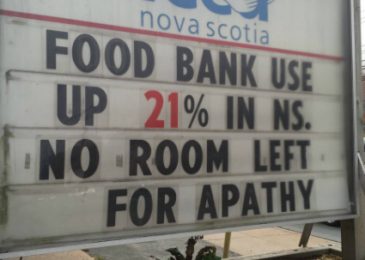KJIPUKTUK (Halifax) – The national food bank statistics for 2015 are in, and the numbers for Nova Scotia are terrible.
Food bank use in Nova Scotia spiked 20.9% over last year—the highest increase among provinces in the country. It’s also a 40.9% increase over 2008.

23,840 Nova Scotians relied on food banks last year.
Halifax Regional Municipality reported the largest growth with a 49.3% change over 2015. Colchester-East Hants Cumberland reported a 29.4% increase, Valley-Yarmouth a 20.7% increase, Antigonish-PictouGuysborough an 18.9% increase, Cape Breton a 7.6% increase, and South Shore a 0.6% increase.
The largest primary source of income category among households assisted by food banks in Nova Scotia continues to be Income Assistance, this year at 56.5%.
The number of households assisted by food banks in Nova Scotia who reported pension as their primary source of income increased from 8.5% in March 2015 to 12.4% in March 2016.
10% of the people who relied on food banks were employed.
30% of Nova Scotia’s food bank users are children.
Meanwhile, the provincial government has refused to increase income assistance rates in a meaningful way. That $20 increase in supports per month we keep hearing about would be laughable if it weren’t so tragic. It’s nothing. It’s a drop in a bucket.
Shelter allowances for people on income assistance, never adequate in the first place, have remained frozen since 2006. Single people receive $300 per month for rent.
British Columbia and Ontario are doing away with child support clawbacks, putting a bit more money in the pockets of single parents on welfare. Nova Scotia is not planning to follow suit.
Nova Scotia just keeps winning these competitions. Here’s another one.
Meanwhile, food banks in Nova Scotia continue to largely rely on charity. Governments continue to deny the causal relationship between the policies they set, be they around welfare or minimum wage, and their outcomes.
It wasn’t always like that. The first food banks in Canada only started appearing in the early eighties.
These days, nobody even blinks when we read that the Colchester food bank is seeking close to $1 million because it has outgrown its current building in Truro. It’s looking at private donors, not at government.
“Our client base never gets smaller, it always get larger,” Beverly Dolter, chairwoman of the food bank’s building committee told the CBC in explanation.
It’s the new normal.
Click here to donate to Feed Nova Scotia.
If you can, please support the Nova Scotia Advocate so that it can continue to cover issues such as poverty, racism, exclusion, workers’ rights and the environment in Nova Scotia.



